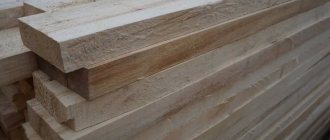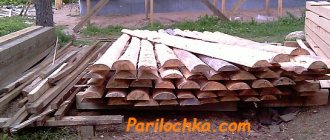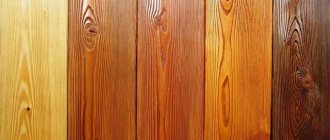Despite the emergence of new synthetic and polymer materials, traditional raw materials, such as natural wood, do not lose their relevance and are actively used in various areas of our lives. And the need for its production is constantly growing. However, compared to other trees, aspen, which is one of the most common woody plants of the Eurasian continent, seems to be a little underestimated and undeservedly “pushed into the shadows.”
Baths and log houses made of aspen
One of the characteristic qualities of common aspen is the high hygroscopicity of its wood, which is why it is often used for the construction of baths and wells.
The main advantages of bathhouses built from aspen timber include:
- Durability and reliability. With high-quality drying of aspen timber used for the construction of a bathhouse, this material gains strength comparable in strength to concrete. Moreover, these characteristics improve even more over time.
- Good moisture resistance. Unlike many trees of other species, aspen does not rot or deteriorate when exposed to water.
- No resinous secretions. Thanks to this, aspen baths do not require additional interior finishing.
- Pleasant unobtrusive aroma. The wood of this tree has a light and pleasant smell, which does not change its intensity when this material is heated.
- Low price. Due to the low cost of raw materials (for example: a cubic meter of unedged aspen board costs approximately 4000-4300 rubles), the construction of bathhouses from aspen is very inexpensive.
- Presence of bactericidal qualities. Even in ancient times, people noticed that the water in wells built from aspen remained clean for a long time, did not rot or bloom, so dishes and utensils were also made from this wood. And in the bath, thanks to the heating of the wood, these qualities were enhanced even more.
Photos of bathhouses and log cabins built from aspen timber
Bathhouse No. 1
Bathhouse No. 2
Log house No. 1
Log house No. 2
Log house No. 3
What is the value of Aspen wood?
Aspen is grown on an industrial scale or parts of wild trees are used. The bark is prepared for the winter and eaten to tonify the body and strengthen the immune system. Branches are added to sauerkraut to increase shelf life. Previously, flour was prepared from this plant, which was used in baking bread. Now this tree is valued for its high-quality wood, and also continues to be used in folk medicine.
The sex of a tree can be determined by the color of the inflorescences.
At home
Despite its ubiquity (aspen can be found throughout Europe and, partly, Asia), its low cost and ease of processing, aspen is rarely used for the construction of houses and farm buildings.
For a long time, people have treated it with some distrust, considering it a weed and unnecessary plant. In addition, according to ancient legend, aspen was the very tree on which Judas Iscariot, who betrayed Jesus Christ, hanged himself by selling him for thirty pieces of silver, so it was believed that the wood of this tree has negative, dead energy.
These beliefs can be treated differently. However, there are very real arguments against using aspen wood as a building material for the construction of houses.
These include:
- Insufficient quality of raw materials. Indeed, in order to find a timber suitable for the construction of a log house, you will have to spend a lot of time. As a rule, no more than 10% of the material from this tree has the required characteristics.
- Susceptibility to shrinkage. Since aspen has high natural humidity, its wood can be used for construction only after thorough drying. However, during this process it is greatly turned out and twisted.
When building houses from aspen, the quality of the timber used is of decisive importance, especially its humidity, which should not exceed 20%. Some experts recommend using aspen only for laying the first crown of a house made of timber, since it resists rotting well and is characterized by increased strength, and the frame itself should be made of pine.
This move will reduce the cost of construction, since the cost of selected quality aspen timber is quite high - from 10,000 per cubic meter. meter and above.
Sound conductivity
The relationship of wood to sound vibrations is determined by sound conductivity, sound absorption, soundproofness and ability to resonate.
Sound conductivity is characterized by the speed of sound propagation in it. Sound travels much faster than through air, and the speed of propagation along the fibers is much greater than across. If the speed of sound propagation in air is taken to be 1, then the speed in wood in different directions will be 2-17 times greater, as can be seen from the table. 5.
Table 2. Sound propagation in wood
| Speed of sound* | Breed | |||
| Pine | Fir | Oak | Aspen | |
| Along the fibers | 15,2 | 10,9 | 12,6 | 16,7 |
| Across the grain in the radial direction | 4,4 | 4,6 | 5,0 | 5,3 |
| in tangential direction | 2,6 | 2,6 | 4,2 | 3,0 |
* Compared to air.
As you can see, sound travels most slowly through the annual layers.
Eurolining, floorboard, unedged aspen
For the interior decoration of baths and saunas, euro-lining made of aspen is used, which is distinguished by its attractive appearance, good moisture resistance and durability.
Its advantages:
- Elegant white color and almost complete absence of knots, due to which a room decorated with this material looks very cozy and neat.
- Not susceptible to rotting and cracking during operation. In a humid environment, euro-lining made from aspen feels excellent, and when dry, it does not change its shape or crack.
- Thanks to the increased dimensions of the groove and tongue, the aspen lining is firmly and reliably fixed to the base, which avoids the occurrence of cracks as a result of constant exposure to humidity and high temperature.
Its dimensions: working width without tenons – 88 mm; width with spike – 96 mm; thickness – 12.5 mm. The length range of the planks is from 1 to 3 meters.
According to a number of characteristics and external qualities, aspen eurolining is divided into 4 grades:
- “EXTRA”, characterized by increased quality, without knots or defects.
- “A”, “B”, “C”, differing from each other by the presence of a certain number of knots and other defects per linear meter.
The video shows aspen lining and its features:
In addition, floorboards are also produced from aspen, which are of fairly high quality and are suitable for finishing baths and saunas. Using a five-point rating scale, this material can be rated “excellent” for its environmental friendliness, visual appeal and durability.
Aspen floorboards are characterized by good hygiene and high wear resistance, so they can be used for a long time without additional repairs or treatments.
In addition, when heated, an aspen floorboard does not burn your feet, which allows it to be used as a very practical and convenient material for finishing the floors of steam rooms and bath rooms.
To perform rougher, “rough” construction work, unedged aspen boards of natural moisture are used. Most often it is used for the manufacture of various types of flooring, as well as the construction of sheathing, elements of load-bearing structures and other works.
A distinctive feature of this material is low cost with high strength and durability.
Description of the Aspen species
The Aspen tree grows up to 15-20 meters in height, some representatives can reach more than 30 meters. This species has a straight columnar trunk up to 1 meter in diameter and gray smooth bark with an olive tint. On average, aspen trees have a lifespan of 80 to 100 years, but some long-lived trees can grow to 150 years or more.
Aspen has several characteristic features:
- the bark remains smooth even in mature trees, sometimes shallow longitudinal cracks appear;
- rounded leaves that are light green at the beginning of the season, then darken, turn yellow and fall off;
- flat, but powerful and wide root system;
- The flowering period occurs at the end of July or beginning of May.
The leaves are round in shape and located on long, flat stalks.
In the photo, the aspen tree can be confused with poplar. To distinguish between these two varieties, it is enough to compare their leaves. They are round and jagged along the perimeter, and their width exceeds their length. Their peculiarity is that they are attached to flat cuttings. Thanks to this shape, they bend well, and at the slightest breath of wind the crown begins to move. The front side of the plate is shiny, the back is matte.
When describing an aspen tree, the shape and color of the flowers also matters. They are bisexual and form inflorescences - catkins. Female flowers are bright burgundy, male flowers are light green. In autumn, seed pods form on them, which are then carried by the wind.
Doors
In addition to being used as a practical and reliable material for the interior decoration of saunas, aspen wood is used to make durable and inexpensive sauna doors.
Door leaves made from this wood have virtually no cracks and do not change their shape and geometry during operation, under constant exposure to high temperatures and humidity.
Their main advantages are:
- Affordability.
- No need for additional care and ease of working with the material (Aspen does not emit resins and can be easily processed with any cutting tool).
- Lightness, high moisture resistance, thanks to which the door made of aspen does not allow valuable and healing steam to escape from the steam room.
Since the texture of aspen is not particularly expressive, to improve the appearance of the door it is often coated with various stains and varnishes. The door leaf is usually made from selected grade wood, with a minimum of knots and defects.
To make the box, simpler and cheaper raw materials are used, since it is closed with a platband and does not stand out in the interior.
Disadvantages: darkening over time and the possibility of hidden rot.
Photos of log houses and doors made of aspen
Doors No. 1
Doors No. 2
Doors No. 3
Doors No. 4
Aspen for soil cultivation
Aspen improves the properties of the soil on which it grows. In autumn, abundant leaf fall can be observed, and trees also shed small branches. Over the winter, this material undergoes a series of chemical transformations and becomes a useful fertilizer. In addition, the root system has its own characteristics. The roots are shallow, but spread over a considerable distance. In the soil in which the aspen grew, multi-level passages remain, which are used by more demanding crops. The cultivation of this species is practiced to improve clayey and insufficiently fertile soils with low moisture conductivity.
Aspen has a powerful root system and often displaces other plants.
Furniture panels made of aspen
People have been using furniture made from natural wood since ancient times. And today it does not lose its relevance and popularity. For its production, wood of various types is used, including common aspen.
Depending on the size of the pressing equipment used, panels, facade elements, decorative panels, etc. are made from it. In this case, the initial wood raw material, which is a 30 mm board with a moisture content of 80%, undergoes pre-treatment: it is impregnated and dried for 70 hours to a moisture content of 10%.
Aspen - characteristics of the tree, beneficial properties, use of aspen in everyday life and medicine
What an aspen tree looks like, where it grows, what are the beneficial properties of the tree and where aspen is used, we will now learn about all this.
The aspen tree is common in temperate climates. This species must be distinguished from poplar, its closest relative. With a slight blow of wind, its crown begins to move, which is why this plant is also called the “trembling poplar.” However, it is valued not only for its decorative qualities. Various parts of the tree are used for construction purposes and medicine, and the shoots are used as animal feed.
Lumber
Since aspen wood raw materials have a number of specific characteristics, they cannot be classified as universal materials that are widespread in construction and industrial production. Therefore, lumber from this tree, for the most part, has limited use.
One of the advantages of lumber is its low cost, however, this only applies to “rough” wood, which has a fairly large rejection rate of about 60-80%. For exterior work, the upper part of the tree is used, since its middle often rots during growth.
Lumber is subject to severe shrinkage and changes in volume and weight during drying, so it is not of great value as a building material.
Negative properties of aspen
Often professionals even refuse to work if they know that they will have to deal with aspen. After all, many properties of wood of this species are negative.
First of all, it is worth mentioning such a negative property as the excessive amount of moisture contained in the structure. The core of the aspen trunk, as a rule, rots because of this. Moreover, the process of decay occurs even before the tree is cut down. But this is just the beginning of all the problems. When delving deeper into the processing process, it turns out that only the top of the tree trunk is suitable for this. It can reach a length of four meters. The same moisture contained in the structure makes aspen wood dry. As a result, one edged board has a very large weight.
In any case, if a person chooses aspen wood for building his house or for renovation work, then more than half of the purchased boards will simply have to be thrown away, since they will be completely unsuitable for work.
Many of them will be crooked. And only a small percentage of aspen boards can be subjected to further processing. ← Aspen broom for a bath Building wood: varieties of species →
Wood processing
Being a fairly common and accessible natural raw material, aspen lends itself well to various types of mechanical processing: sawing, cutting, peeling, planing, etc. The largest percentage of material entering processing falls on plywood-match, pulp and paper, container production and sawmilling.
Since aspen wood survives peeling and planing operations well, it is successfully used for the manufacture of plywood and matches. At the same time, it is especially highly valued in match production.
Due to the absence of resinous and aromatic secretions, aspen wood is suitable for the production of barrels and boxes. Also, this material, which has a natural white color and a sufficient length of fibers, is used for the manufacture of paper and cardboard, fiberboard, particle boards, etc.
In addition, after appropriate processing, aspen wood can serve as a raw material for hydrolysis-yeast production, the production of a petroleum fuel substitute and other purposes.
The video shows the processing of aspen waste from a match factory on a granulation line:
Industrial felling of aspen
The international standard for industrial wood is called DIN 4076. Aspen wood belongs to group AS.
In Russia, industrial cutting of trees is carried out in wild forest plots, which are then restored naturally. In Western Europe, in recent decades, trees for industrial felling have increasingly been grown in nurseries. These are the so-called short-cycle forest nurseries. They grow primarily fast-growing tree species (poplar, aspen). This approach to environmental management makes it possible to preserve natural forests and grow wood of the required parameters.
Reproduction
It is curious that seed germination takes several days. Soon after falling out of the boxes they die. Thus, young shoots appear only from the seeds of this year - in the summer, where they fell into fertile soil. Optimal conditions for germination are bare soil and high humidity (rain). Since the soil in forests is always covered with dry grass or fallen leaves, aspen seeds germinate quite rarely.
In a forest or open space, a mature tall tree is always surrounded by young and low growth. Digging deeper under a young tree, it is easy to discover a thick root, tending towards the parent plant almost horizontally. The abundance of shoots is amazing - each root produces 10 or more shoots, with a large distance between them. Reproduction of aspen in the forest is almost always vegetative.











